Plumerias are so exotic and beautiful that it seems like they would be difficult to care for. But they’re actually quite easy to grow once you learn how.
In this post, I’ll tell you all you need to know about how to grow plumerias, including water, soil, fertilizer, and light, as well as tips one propagating, pruning, flowering, and more.
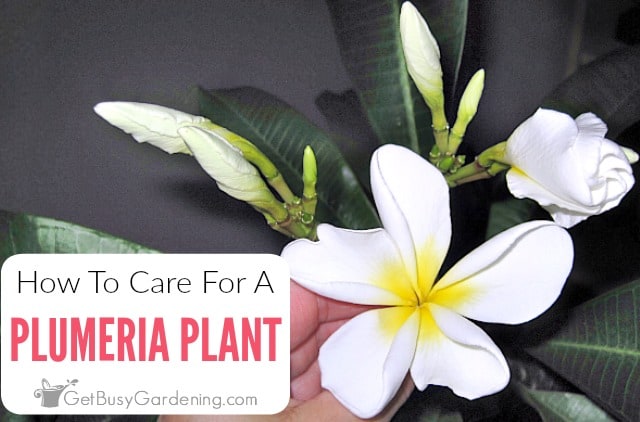
When I think back to my trips to Hawaii, one thing that I remember the most was all of the gorgeous plumerias growing and blooming everywhere.
So of course, I absolutely had to bring one home with me when I went back to Minnesota.
My new baby Hawaiian lai plant was only about a foot tall when I got it, and it bloomed shortly after I brought it home.
I instantly feel in love, and was pleasantly surprised by how low maintenance it was. If you want to try one for yourself, then you’re in the right place.
Below I’ll tell you everything you need to know about their care, and show you how to grow plumeria no matter where you live.
Plumeria Quick Care Overview
| Scientific name: | Plumeria |
| Classification: | Tropical plant |
| Common names: | Frangipani, Hawaiian Lei Plant, Kalachuchi, Champa Flower |
| Hardiness: | Zones 10+ |
| Temperature: | 60-75°F |
| Flowers: | Colors and bloom times vary by species |
| Light: | Full to partial shade, bright light indoors |
| Water: | Allow soil to dry slightly, do not overwater |
| Humidity: | Moderate to low |
| Fertilizer: | Flowering plant food in spring and summer |
| Soil: | Fast-draining, fertile soil |
| Common pests: | Spider mites, whiteflies |
Information About Plumerias
Plumerias are popular tropical plants that can grow into huge trees in their native environment.
You might know them better as a Hawaiian Lei Plant (plumerias are the type of flowers traditionally used to make leis), or maybe by their less common name, Frangipani.
But don’t let their common name fool you, they aren’t actually native to Hawaii. They’re originally from the tropical regions in Central and South America, as well as parts of the Caribbean.
Different Types Of Plumeria
There are several different varieties of plumerias, some can become large trees, while others are smaller shrubs. But they all require the same care and attention. Here are a few of the most common.
- Plumeria pudica – Also known as Bridal Bouquet because of the white flowers, this is one of the hardier varieties that can survive down to zone 9. It can reach 15-20′ tall.
- Plumeria rubra – This is one of the more common types, and there are several hybrids. Depending on the cultivar, they can grow anywhere from 6-30′. The flowers come in just about any color too, and some can bloom year round.
- Plumeria obtusa – There are a few cultivars of this one too, many of which are shorter dwarf varieties. Colors and bloom times also vary between them.
- Plumeria alba – Sometimes commonly called a Nosegay Tree, this species is another one that can grow 6-30′ in height.
Flowers
As I’m sure you probably already know, plumeria is prized for their gorgeous, and highly fragrant flowers.
Depending on the species, they can be just about any color, and some individual blossoms even contain more than one.
The time of year totally depends on the variety. Some only flower in late winter through spring or summer, while others will bloom profusely all year long.

Toxicity
The sap can cause irritation for those with sensitive skin, and is also toxic to cats, dogs, and people if ingested.
Though they’re only mildly poisonous, it’s best to keep them out of reach of your kids and pets if this is a concern for you. The ASPCA website is a great source for more information.
How To Grow Plumeria
Before we jump into the details of plumeria plant care, first we should chat about where to grow them. Choosing the right location is key to long-lasting, sustained health.
Hardiness
Most frangipani plants can only live outdoors in zones 10 or higher, though there are few that can survive down to zone 9.
They’re very sensitive to the cold, and will drop their leaves or turn yellow or brown in the fall, even in warmer areas.
Where To Grow Plumeria Plants
In warm enough climates, plumerias can grow into very large trees, so they will need a lot of space in your yard.
If you want to restrict their size, you can put them in a container instead of in the ground, they do very in pots.
They can also thrive indoors in a spot with plenty of light. Although it’s very uncommon for them to bloom inside the house.
For that reason, I find it’s much easier to put them outside in the summer to maintain their health and growth, and also encourage flowering.

Plumeria Plant Care & Growing Instructions
With the proper care, plumerias can live for many years. Now that you know where to plant them, let’s chat about their needs. Follow these tips to keep your plumeria growing and blooming year after year.
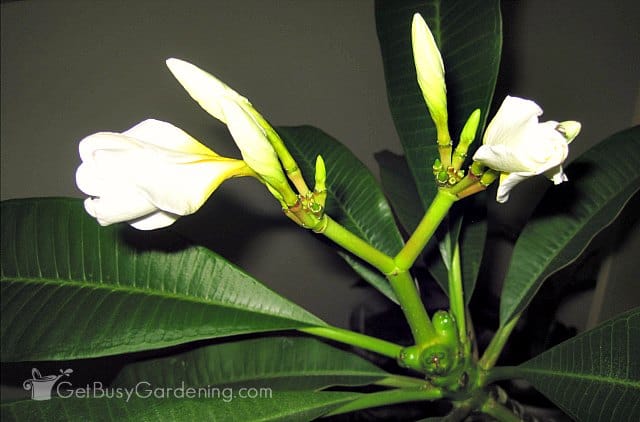
Watering Requirements
Plumerias like a lot of water, but won’t tolerate being overwatered. When they’re too wet, the trunk will rot, and it will eventually kill the plant.
It’s kind of a funny combination, give it a lot of water… but don’t overwater? I know, but don’t worry it’s actually pretty easy. A moisture gauge will help you get it right.
During the summer months, give it a really good, deep drink. Allow the excess to drain completely, and wait until it’s mostly dry before adding more.
Since they go dormant during the winter, it’s best to water them very sparingly, if at all, during those months.
Humidity
You might be surprised to learn that plumeria plants prefer moderate to low humidity levels.
If it’s extremely dry in your home, you can place a humidifier next to it to help add extra moisture to the air.
However, be careful misting or spraying them with water, you don’t want to overdo it. If droplets are constantly sitting on the branches or leaves, it could cause them to rot.
Light Requirements
Plumerias need full sun in order to grow their best and also to bloom, otherwise they will become sparse and leggy.
If yours is outside, put it in a full sun location. Otherwise if it’s indoors year round, then you’ll likely need to get a grow light.
When you move it outside for the summer, don’t give it full exposure right away, or it could burn. Instead, put it in the shade for a few days, and gradually introduce it to a full sun location.
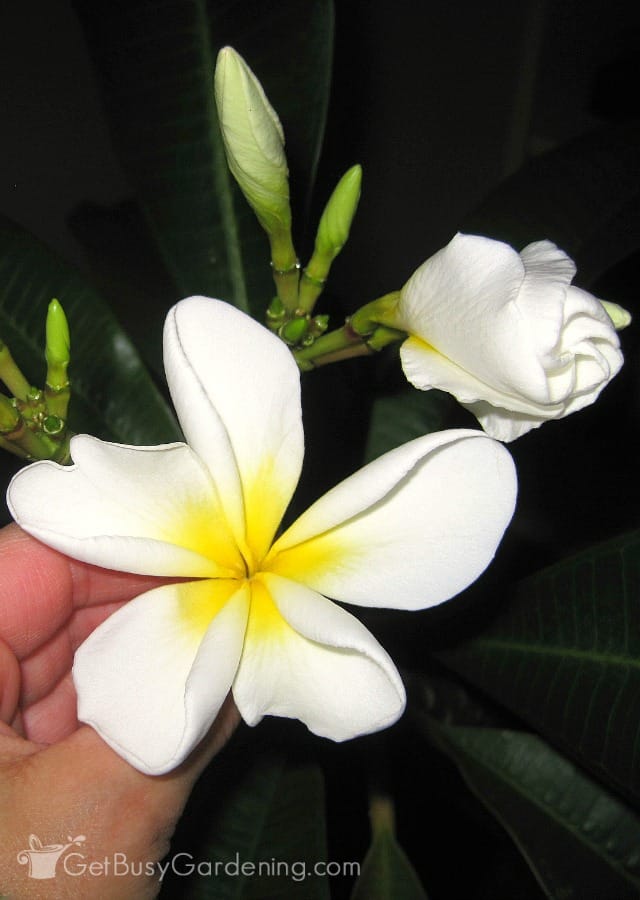
Temperature
Plumerias are not cold hardy plants. Their ideal temperature range is between 60-75°F.
If it gets much colder, they’ll start dropping their leaves, and below freezing temps will quickly kill them. Even a light frost can damage the tender branch tips.
Hotter weather doesn’t often bother them, though the high heat in arid climates will dry them out too quickly.
Best Soil
The best soil for successful plumeria plant care is a fast draining mix that’s slightly acidic, ranging between 6-7 on a pH meter.
You don’t necessarily need to buy any special type, and you can even make your own if you want.
I grow mine in a homemade mixture of 2 parts general purpose soil with 1 part each of either perlite or pumice, and sand.
Find out more about how to choose the best soil for your plumeria, including my recipe to make your own in my detailed guide.
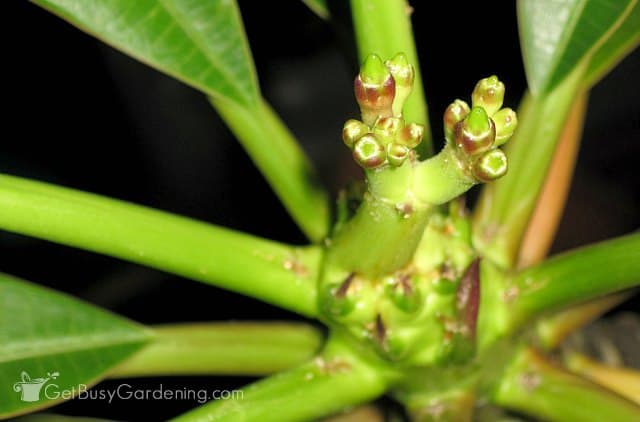
Fertilizer
As I already mentioned, plumerias are very heavy feeders, and fertilizing is an important part of their care.
They need a type that is high in phosphorus in order to bloom. Apply an organic liquid flower food every 1-3 weeks in the spring and summer. You can also apply granules monthly to provide even more nutrients.
Fertilize them from spring through summer, and stop in early fall. Then don’t feed them at all during the winter.
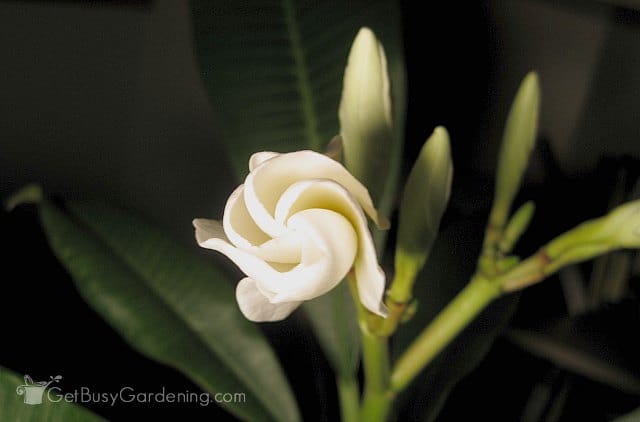
Repotting
With the proper care, frangipani trees can grow very rapidly, and may need repotting every 1-2 years.
When roots begin to come out of the drainage holes, or growth slows, it’s a sign they need to be sized up.
In the spring, move them into a container 2-4” larger than the current one. Replant it at the same depth, and expect some leaf drop or drooping as they recover.
If you want to limit their size, simply refresh the top few inches of soil and trim away some of the roots.
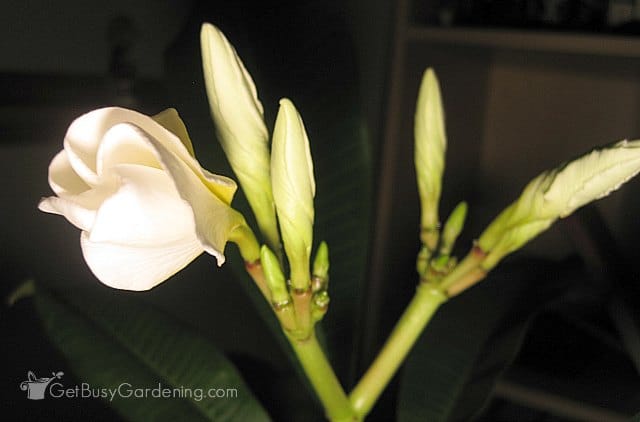
Tips For Controlling Plumeria Pests
Though pests aren’t usually an issue outdoors, plumerias can have problems with spider mites and whiteflies indoors.
If yours gets attacked by bugs, begin treating it right away. I recommend using neem oil, which is a natural pesticide that works great.
Organic insecticidal soap is also a good option. I sometimes make my own by mixing 1 tsp mild liquid soap per 1 liter of water.
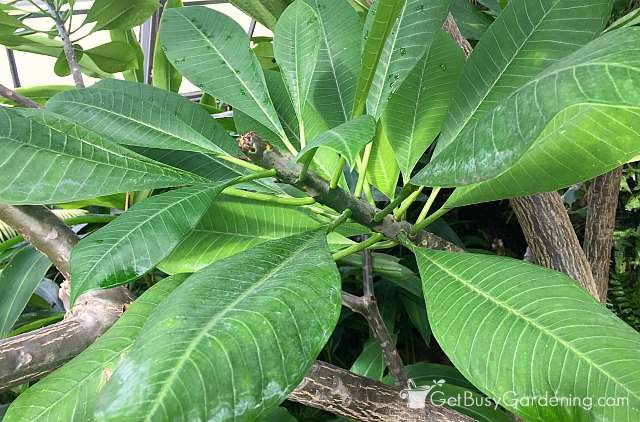
Pruning
Plumeria plants benefit from regular pruning as a part of their care routine. They can handle being trimmed back pretty severely, but never cut them all the way down to the ground.
The best time to do it is in the spring, or right after they’re done blooming.
Use sterile and sharp pruning shears so you get a nice clean cut. For thicker branches, you may need to use a lopper. Also, wear eye protection and gloves to protect against the sap.
Always make your cuts at a downward angle, so water can’t settle into the wound and cause the branch to rot.
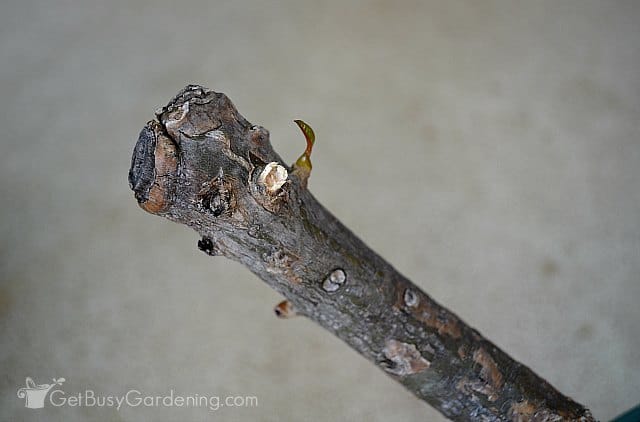
Plumeria Propagation Tips
Though they can be grown from seed, most home gardeners propagate their plumeria by taking cuttings.
It’s pretty easy to do. Simply take a section from a healthy branch, remove the flowers and leaves, and allow it to cure for several days.
Dip the cut end in rooting hormone, then place it into a slightly moist medium. Keep it in a warm spot until you see new growth on top. Get my step-by-step tutorial for how to propagate the cuttings here.
Plumeria Winter Care & Dormancy
Once the temperature starts to cool in the fall, and there’s less sunlight, your plumeria will start to go dormant naturally. This is the time to stop fertilizing, and slow down on watering.
The leaves will turn yellow and then brown before finally dropping off. This is totally normal, so don’t panic. It might not drop all of the leaves though, and that’s ok too.
If you live in a cold climate, this makes is much easier to overwinter them indoors. So there’s no need for artificial lights or a sunny window.
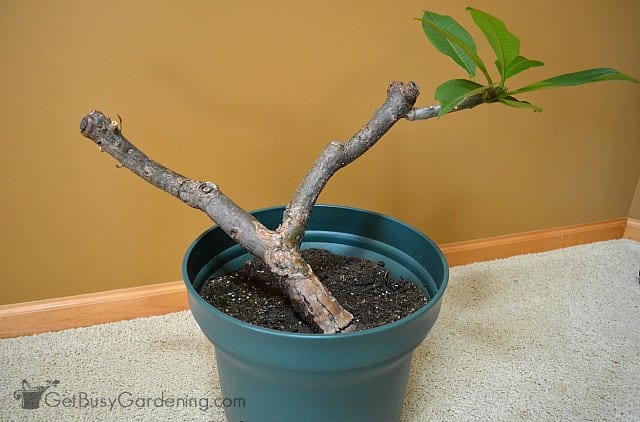
Troubleshooting Common Plumeria Care Problems
Though plumeria are fairly simple to care for, they are notorious for having a few problems. Below I’ll help you troubleshoot and fix the most common issues.
Tip Rot
In my experience, tip rot is a pretty common problem. It happens when water settles in a crack or wound on the end of a branch, which is usually caused by improper pruning or frost damage.
If left untreated, the rot will spread, and could eventually kill the plant. You can save it by cutting off all of the rotted pieces of the affected branch.
Stem Rot
If the stem is mushy and rotting at the base, then you have a more serious problem. Stem rot is caused by overwatering.
If left untreated, your plant will die for sure. If the rot isn’t too severe, you can save it by taking cuttings of the healthy stems or branches and rooting them.
Plumeria Won’t Bloom
This is probably the #1 question I get asked about growing plumerias, and there is one simple answer… fertilizer.
They need fertilizer in order to bloom, and lots of it. The good news is that it’s such an easy fix. Once you get the hang of it, they will flower profusely for you.
Leaves Falling Off / Dropping
Leaf drop can be caused by a lack of water or cold temperatures. It’s natural for them to go dormant during the winter when it gets below 50°F, and this is nothing to worry about.
However, if it happens during the summer, then check to make sure they’re getting enough water. They should never dry out completely. Also inspect the branches and trunk for signs of rot.
Leaves Turning Yellow
Yellow leaves are also a sign that they’re starting to go dormant, however it could be from overwatering, pests, or disease.
Check the soil to make sure it’s not wet or soggy, inspect the leaves for bugs, and verify that the stems are firm and not rotting.
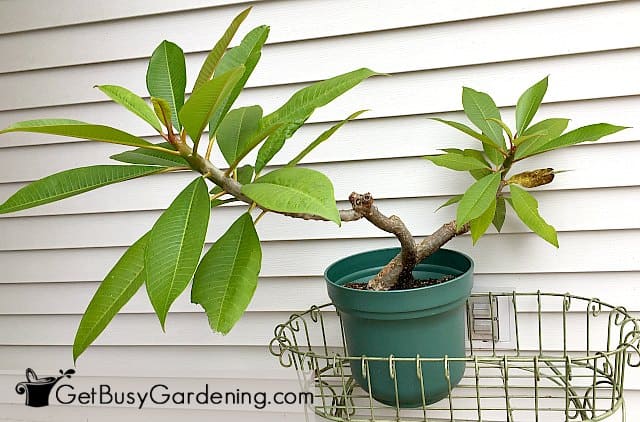
FAQs
In this section I’ve answered some of the most frequently asked questions about plumeria care. If yours isn’t listed, please ask in the comments below.
Are plumeria hard to care for?
No, plumeria are not hard to care for. They’re actually quite easy to grow, as long as you understand their requirements.
How long does it take for a plumeria to be full grown?
How long it takes for a plumeria to be full grown totally depends on the variety. Some grow must faster than others, though on average they can put on 12-36″ per year with the proper care.
Is plumeria an indoor or outdoor plant?
Plumeria can be either an indoor or outdoor plant, depending on where you live. They’re only hardy in the warmest regions, so people in cold climates must bring them indoors during winter.
Is plumeria a succulent?
No, technically plumeria is not a succulent, they are tropical plants. Though they do have some similar care requirements and properties.
Is frangipani the same as plumeria?
Yes, frangipani is the same plant as plumeria. Frangipani is the common name for them. Plumeria is technically the scientific name, though many people also call them that since it’s easier to pronounce.
Plumerias are wonderful plants that are surprisingly easy to care for. Once you know the tricks for growing them, you’ll be able to keep yours thriving for decades to come.
If you want to learn all there is to know about maintaining healthy indoor plants, then you need my Houseplant Care eBook. It will show you everything you need to know about how to keep every plant in your home thriving. Download your copy now!
More Houseplant Care Guides
- How To Grow Begonia Plants
- Wandering Jew Plant Care & Growing Guide
- African Milk Tree: How To Grow & Care For A Euphorbia trigona Plant
Share your plumeria plant care and growing tips in the comments section below.


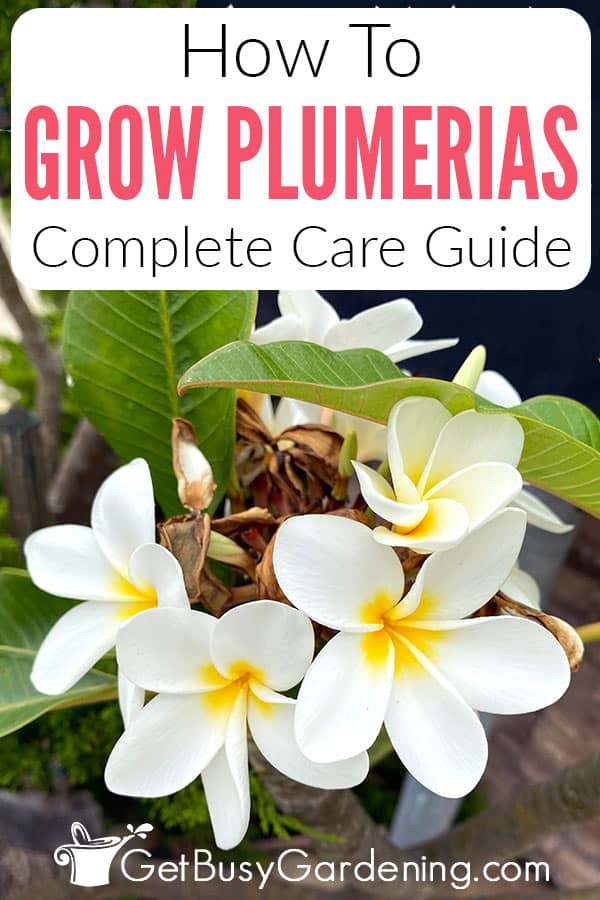
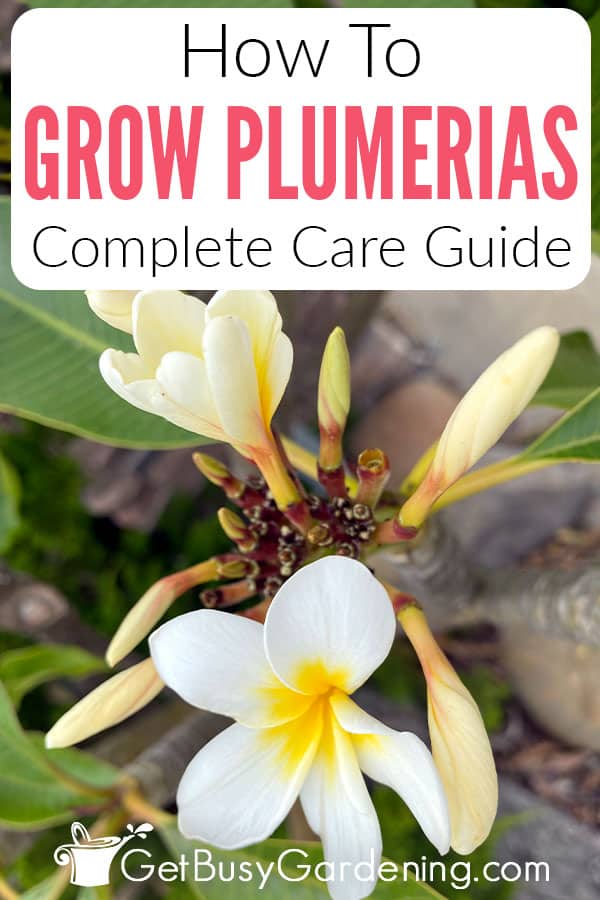
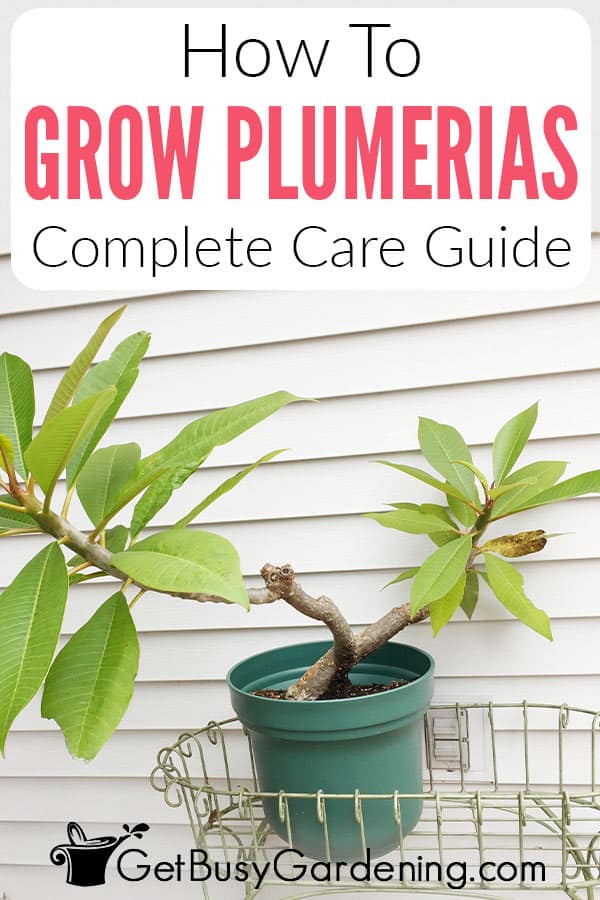
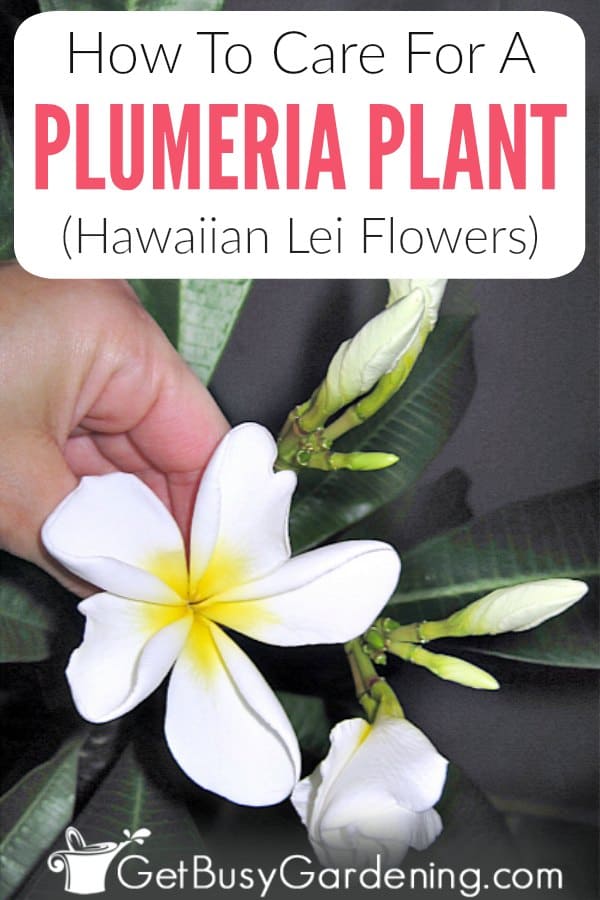



Cindy says
Hello, I have an indoor plumeria, grown from a cutting. It is still a young plant in its first year . It’s leaves have always curled under on edges . What causes this ?
Please help.
Amy Andrychowicz says
When the leaves curl under, that’s usually an indication of a pest infestation. Spider mites can be a problem and cause curling edges, so check closely under the leaves for any signs of webbing or bugs. Otherwise, it may just be going dormant for the winter.
Gloria says
It’s only Aug. 20. and my plumerias 🌱 are dropping their leaves 🍁 could I be overwatering them? This never happened before. Thank you for your help. Someone in Texas.
Amy Andrychowicz says
They could be going into early dormancy. But check the stem to make sure it’s not soft or rotting. Plumerias will start to drop their leaves if the stem is no longer healthy. Also, make sure you’re giving them the right amount of water, as keeping them too dry or too wet can also cause leaf drop.
Daniel Stecky says
How many different plumeria are there an where can l get others as far as different colors of flowers thank you
Amy Andrychowicz says
There are hundreds of different types of plumeria. You should be able to find them online. I’ve bought some cuttings through Amazon will good results. But I’m sure there are online retailers that specialize in selling plumerias specifically. Otherwise, if you live in a warm enough climate, your local garden center should have several options.
Tyler Scott Kirk says
Should I cut off the small branch’s where the flowers bloom when it’s time to prune?
Amy Andrychowicz says
It’s best to wait to prune your plumeria until after it’s done flowering for the season.
Sherry says
where did Sharon Hunter find her seed pod.
Hi! I’m Sherry
I also found something on my Plumeria, they are on the end of the insaid. Is that what the flowers form on. So do seed pods form on the insaids?
Amy Andrychowicz says
Sorry but I’m not sure what you mean when you say “insaid”. Plumeria flowers form on stems that grow at the tips of the branches. The seed pods will form at the end of the flower stem once the blossoms fade and drop off. The pods are quite large, you can’t miss them.
Kevin Robeson says
How big (tall) does a potted plumeria have to get to bloom?
Amy Andrychowicz says
Plumerias don’t need to reach a certain size in order to bloom, then can flower at any size. I had a 12″ tall one bloom the first year I had it. The trick to getting them to bloom if fertilizer, fertilizer, fertilizer. 🙂
Sharon Hunter says
My plumevera plant has two cigar looking things on in the are about 6 inches was and in 9 years this has never happened what are they
Amy Andrychowicz says
Those are plumeria seed pods, how fun! You can cut them off if you want, or leave them on to gather the seeds for fun.
Sakin says
Hi,
I live in Southern California and it does not get to cold where I live. I would like to keep my plumerias in a pot out doors all year. Will the rainy season kill them if they are kept potted out doors?
Amy Andrychowicz says
I see plumerias growing all over southern CA, so they will love being outside where you live. Just make sure they are in a pot that has good drainage holes, and in fast-draining soil, and they will thrive outside in sunny CA. 🙂
Cathy Sams says
Hi Amy! I live in Jacksonville Beach, FL and have several young Frangipani’s that are doing well. My concern is that a few of them are getting very top heavy and starting to lean and touch the ground. I’ve read not to prune the plants until late spring or in the winter. It’s mid June now, so should I just leave them alone and wait until it’s time to prune? I’ve thought about propping to branches up, so they are not laying on the ground. Your thoughts?
Amy Andrychowicz says
Since they are young, you certainly could try staking your Frangipanis to prevent the branches from sitting on the ground. The best time to prune them is after they’re done flowering – otherwise, you’ll cut off the new flower buds. But, if you would rather prune your plumeria now to get it to grow more upright and bushy, it’s certainly not going to hurt. Just make sure that you make the cuts at a downward angle to prevent water from pooling in the wounds (which can cause tip rot).
Phyllis says
I have a three armed Plumeria. One arm (about 4 to 5 “) started to die off at the tip. About 1 & 1/2 “ is black and shrinking. I am wondering if I should cut it off before it reaches the main branch or leave it. I can’t seem to find any information about this problem. I would really appreciate your expertise on this. Thank so much for taking your time to read this.
Amy Andrychowicz says
It sounds to me like your plumeria has tip rot, which is a very common problem for them. You should definitely prune it off, or it will just continue to spread down the branches, and could eventually kill the entire plant. Make sure that you get all of the rotted parts when you prune it, and make your cuts at a downward angle so water can’t pool in the wounds and cause it to rot again.
Nancy mclennan says
My plumeria had a lot of leaves the first year which have all fallen off and went dormant, however, it is now April and I am not sure if it is still living as nothing is showing any new signs of new growth, it is potted and was in my home all winter. Any way to tell if it is going to make it, and if so what should I be doing.
Amy Andrychowicz says
Depending on where you live and what the weather has been like this spring, it could take longer for your plumeria to wake up from dormancy. Some years, mine doesn’t show any signs of life until May (I’m in zone 4b). As long as the stem is firm, then it should still be alive. You can usually also see tiny leaf buds at the tips of the stems, which is another way to tell that your plumeria is still alive. Just give it plenty of light, and water a little more often to help wake it up (be careful not to overwater though, the soil should dry out between waterings). Once it’s consistently above 50F, then you can leave it outside for the summer, which will also help it break dormancy.
Barbarah says
I’m in South St Paul, MN
I was told to use any kind of sand. Would succulent soil be better?
Amy Andrychowicz says
You can mix sand into the potting soil to make it drain faster for your plumeria. Otherwise, yes, succulent soil would be a great choice. Here’s my recipe if you want to try to make your own.. How To Make Your Own Succulent Soil.
Lynn says
I live in zone 9 Folsom California. I have had my plumeria in the garage overwintering and wonder what temperature range it needs to be outside before I bring him out again.
Amy Andrychowicz says
You can bring your plumeria back outside in the spring once all chance of frost is gone.
Karen Erwin says
How do I take care of tip rot on my plumeria?
Amy Andrychowicz says
Oh no, sorry to hear your plumeria has tip rot! That is a very common problem, unfortunately. The only way to save it is to prune off all the rot, starting from the tip down. Start by cutting off the rotted part. Then check the remaining stem. If there’s still rot, keep cutting until it’s all gone. Make each cut at a downward facing angle to prevent water from pooling in the wound, and causing it to rot again in the future. Good luck!
Helen says
Does plumeria need to milk after cutting tip off from tip rot?
Amy Andrychowicz says
Sorry, but I’m not sure I understand the question. Yes, sap (a white milk-like substance) will drip out of the wound after you cut off the tip of your plumeria. But there’s nothing special you need to do with it. The sap will dry up, and the wound will callus over on its own. Just make sure you get all of the rot off when you cut it back.
THERESA DUNBAR says
hi Im new to plumeria care. I have three little plants with some roots and one with little leaves.
I also have some cutting some one sent me from Maui.
IM in Long Island. I put them near a sunny window and just put plant lite on them.
please give me instructions on how to care for these babies/!!
Amy Andrychowicz says
Sounds like you’re doing everything right so far. For detailed plumeria care instructions, please read through the post. Then let me know if you have any specific questions. 🙂
Cindy Beebe says
My potted plumeria is growing straight up and very thin, with no branches. What can I do to get it to thicken up? And if the answer is to clip it, when is the best time of year to do that and how much? It’s about 2 feet tall. Thank you for any information
Amy Andrychowicz says
Yes, you are correct, you need to prune your plumeria to encourage branching. Late winter/early spring is the best time to do that. Read through the section above titled “How To Prune Plumeria Plants” for all the details.